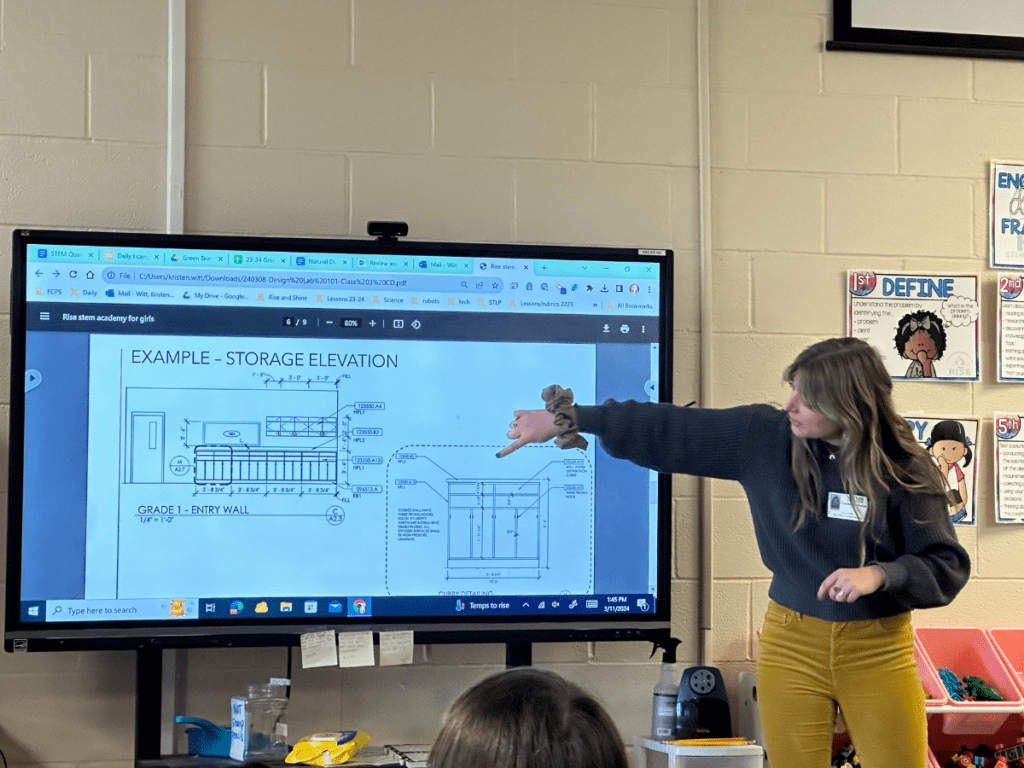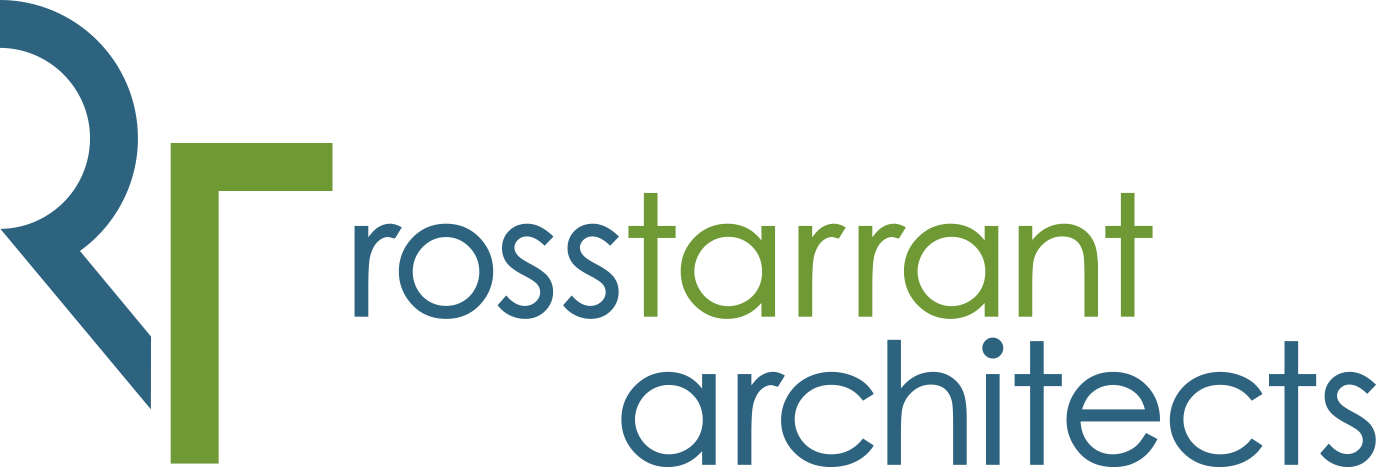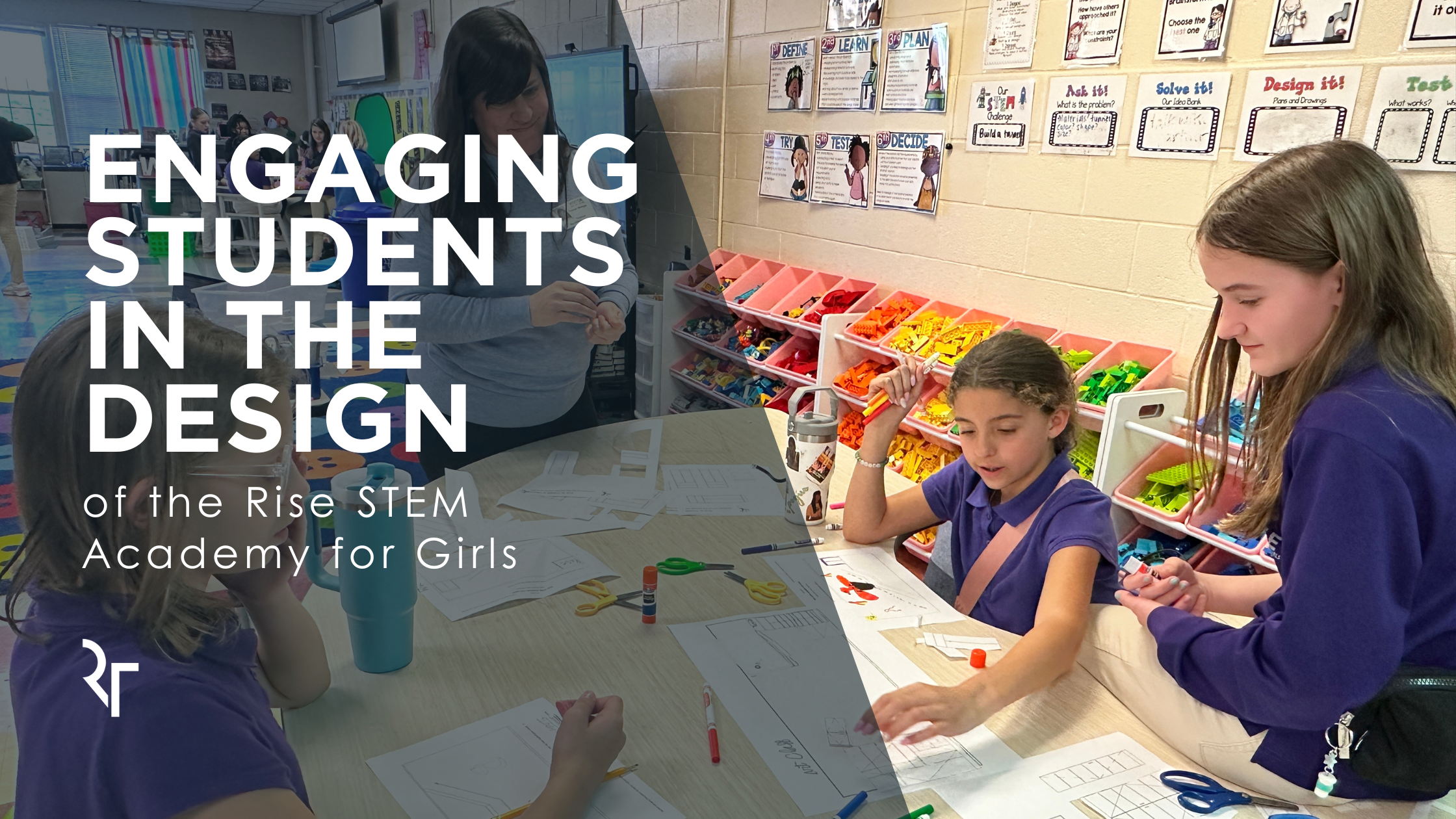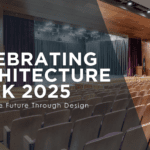What happens when students contribute to the design of their own school? RTA and Fayette County Public Schools decided to find out. Working together to create a new home for the Rise STEM Academy for Girls, they immediately recognized the rich learning opportunity the project could provide for students, and Design Lab 101 was born. Spearheaded by RTA staff members Elizabeth Johnson, Faye Bahrami, Irene Kapinga, Tristan Morgan, and Lauren Delventhal, the five-session Design Lab sought to educate the students about potential careers in architecture, interior design, engineering and construction while infusing the new Rise STEM Academy for Girls with school spirit, pride and a sense of student ownership.

Kickoff & Objectives
RTA’s female designers jumped at the chance to mentor these amazing students, giving them hands-on experience in multiple STEM professions in which women are far underrepresented. The series spanned over the 2023-2024 school year, turning an existing makerspace classroom into a design laboratory that engaged 45 fifth-grade girls in every phase of their school’s design. The unique, hands-on learning experience left teachers, students and RTA’s design team feeling deeply inspired, and it resulted in a collaboration that has proven to be a foundational step in shaping the school’s future.
Program Structure & Activities
Each session of the rigorous program started with a brief presentation to orient students to their school’s current phase of design. School staff and RTA’s own female designers worked together as models and mentors to facilitate interactive activities, from individual exercises to group challenges. Student engagement and creativity quickly proved to be an inspiring and invaluable contribution to the school’s design and the themes the group discovered together infused every phase of design moving forward.

Tresine Logsdon and Irene Kapinga collaborating with students on a group activity.
Session 1: Schematic Design Phase
In the initial session, the RTA mentors challenged students to draw visions of their ideal new school. The images they produced reflected dreams of spacious gyms, joyful playgrounds and vibrant makerspaces. An emphasis on school pride was immediately evident, with students showcasing a deep affinity for their school colors and logos.
Next, students explored the arrangement of building blocks, organizing classrooms and common spaces into logical arrangements and taking into consideration logistical drivers like front door access and circulation pathways. Some students even felt inspired to explore creative exterior features like playgrounds, outdoor classrooms and traffic flow in their designs.
Session 2: Design Development Phase
The second Design Lab was hands-on and focused on tactile experiences. Students interacted with physical material options including tile, carpet, and terrazzo samples. RTA mentors taught students about material properties and their appropriate applications in different types of spaces. Students then grouped together to match materials to specific areas on a schematic floor plan and created a legend to identify their selections. Students were then tasked with working individually to create floor patterns that utilized color to simplify wayfinding and establish the individual identities of grade-specific spaces.

An original sketch from a Rise STEM Academy student during the individual exercise.
Session 3: Construction Documents
The third Design Lab introduced students to the technical details of design documentation. The RTA mentors presented a better understanding on elevations, storage needs, and special organization for spaces like art rooms and classrooms. One of the highlights was an individual exercise where they designed graphics for the main entrance lobby, focusing on school identity and empowerment themes.

An original sketch from a Rise STEM Academy student during the individual exercise.
Session 4: Bidding Phase
This session brought the bidding process to life through role-playing. Students split into groups representing different contractors, preparing and submitting bids. The interactive activity, complete with envelopes and a ticking clock, taught them about bid evaluation and the importance of balanced pricing. Candy incentives added a fun twist, and the students worked together to select the winning bidder.

RTA Mentor, Faye Bahrami, leading the students in the Bidding Phase exercise.
Session 5: Construction Administration Phase
In the final session, the students were introduced to the construction process. While their building is not yet under construction, students enjoyed a video of a job site and learned about the steps in the construction process. This session reinforced the practical aspects of turning design into reality, providing a comprehensive view of the architect’s role during construction.
Impact and Takeaways
The entire Design Lab program had a profound impact on both students and RTA team. Student engagement both influenced and reinforced the new school’s design direction and provided clarity to the RTA/FCPS design team on the critical importance of reinforcing school culture, showcasing student work, the use of vibrant colors, and supporting inclusiveness and community in creating a school designed to elevate girls in STEM.
Interior designer Elizabeth Johnson was struck by one student’s floor pattern that included lots of star shapes. “She told me, “it’s because we’re all stars”, and I was moved by just how much this work we are doing really matters.”
“You never know if we said something that may have just led someone toward their future career,” noted Lauren Delventhal, the Project Coordinator on the Rise STEM Academy for Girls.
 RTA Mentor, Elizabeth Johnson, presenting the Construction Document Phase.
RTA Mentor, Elizabeth Johnson, presenting the Construction Document Phase.
Student and Teacher Feedback
Feedback on the Design Lab program was overwhelmingly positive. Teachers commented they appreciated the ease of integration into their schedules, while students said they looked forward to each session with excitement. They reportedly appreciated how the balance of group and individual activities fostered collaboration skills and enabled them to explore their personal creativity.
Trisene Logsdon, Energy and Sustainability Cirriulum Coordinator at Fayette County Public Schools said, “Our students possess an inherent curiosity about our built environment, STEAM careers in design and construction and our collective impact on our shared natural world. Leveraging our design projects and buildings as 3D textbooks, students serve as their school community’s local experts on how a new school will impact instructional strategies and our shared ecosystem, all the while learning first-hand how to prepare for a career in design and construction. RTA prioritized our students’ insight and opinions and designed creative and engaging activities to incorporate students’ ideas into their new school building.”

Rise STEM Academy students working on potential designs for the new school lobby.
The Design Lab 101 Series did more than just teach students about architecture, interiors, engineering, and construction. It empowered 45 fifth-grade girls to contribute in a meaningful way to the new school that will one day be home to future generations of girls in STEM. Meanwhile, it helped the design team make a very personal connection to the students they are designing the new school to serve, and it infused the new school’s design with elements designed by students for students. Through this collaborative effort, the Design Lab 101 Series has ensured that the new school will not only inspire future generations of girls in STEM but also serve as a lasting testament to their creativity and vision.







